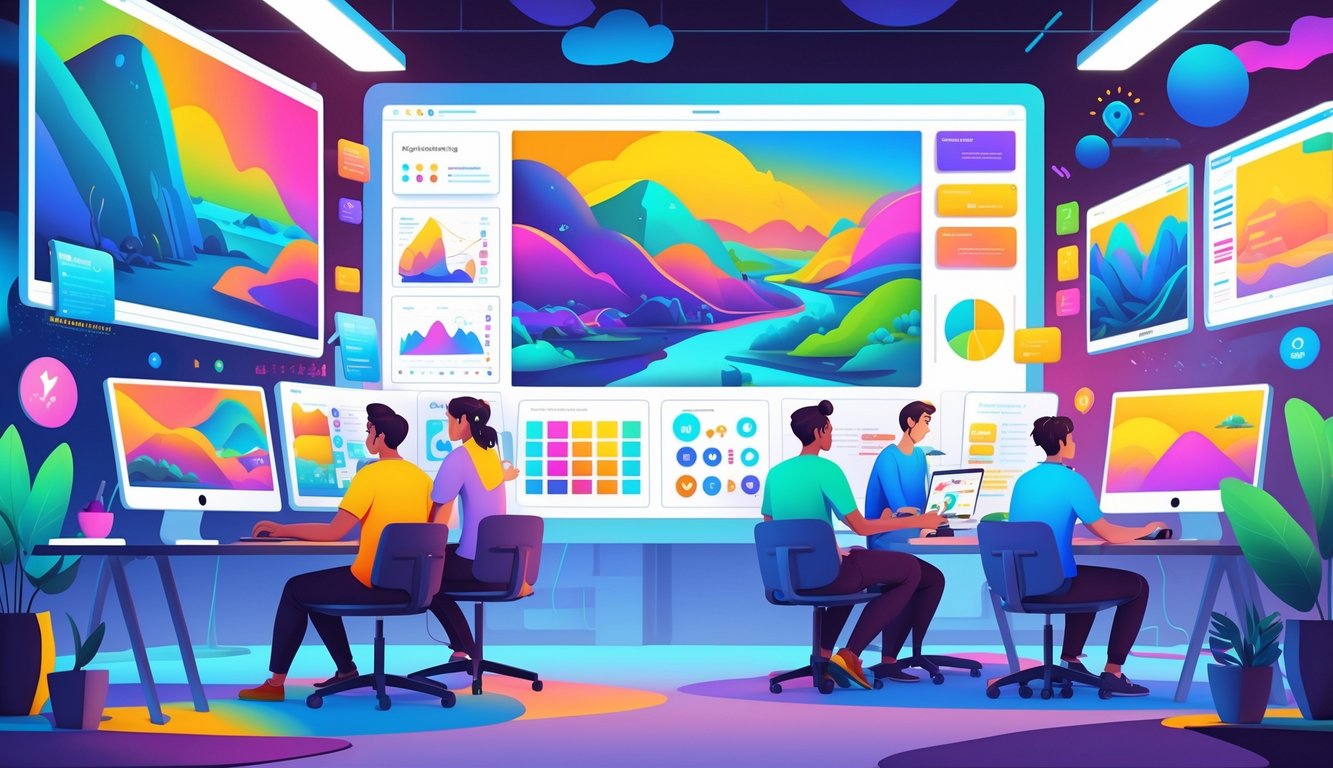
Mastering Materials and Texturing Techniques
Texture creation’s supposed to be easy by now, right? Nope. My PC disagrees. I spend hours layering grunge maps over sculpted tileables in ZBrush and pretending it’s productive. Substance Painter and its endless tutorials have saved me more than once—except when it updates mid-project and eats my work. Trim sheets? Way harder than YouTube says, but the payoff is real.
Substance Painter for Material Creation
If you haven’t been cornered at a meetup by someone preaching Substance Painter, did you even go? It’s not magic. But it works. Like, FastTrackTutorials and a million portfolios can’t all be lying.
Anchoring points speed things up. I dump my base, toss an anchor, slap on a detail pass. Blend metallics, normals, whatever—drag, drop, tweak, export. I read somewhere “unique texturing workflows save up to 30% time.” Check for yourself if you want.
UVs still haunt you, but at least you stop stressing about seams. I’ve seen artists duplicate edgewear passes a dozen times, and—honestly—layering still looks best. Efficiency isn’t fixing my caffeine habit, but at least texturing feels less pointless.
Tileable Materials and Trim Sheet Textures
Tileable textures used to be the worst. I’d sculpt a patch in ZBrush, bake normals, pray nobody zoomed in. Now, trim sheets have bulldozed into my workflow thanks to FastTrackTutorials. Suddenly, three environments done with what feels like no effort.
I didn’t get why we made so many tileables until I saw the lightmap performance—high-res detail, less memory. I overheard a studio lead say: bake soft grunge right into trims, instant realism, no extra steps. Still, sometimes I’m retouching AO by hand when scans come out weird.
Mixing procedural Substance materials with hand tweaks adds grit. Nobody cares how fast you made it if the tiling’s obvious—break it up with decals if you have to (I once used a random bird poop alpha at 3 am, and it stayed).
Texturing in Environment and Character Art
Texturing characters vs. props? I wasted months making generic dirt for everything because “consistency” was trendy. Turns out, unique grunge maps matter way more in focal areas. Environments want bulk: tileable bases, overlays, decals. Characters? All about pores and roughness for cheekbones—nobody’s skin is perfect.
A senior artist once said, “Push contrast in cavity maps; subtlety dies in game lighting.” True, but if you ignore roughness, all your work gets nuked by post-process. When Substance updates break my project (they will), I just patch by hand.
Material tutorials taught me that even cheap assets look fancy with three smart masks and some noise. Nobody’s going to clap for your UVs. If you want step-by-step breakdowns, there’s this insane course library, but the truth is, half your textures get redone anyway.
Creating Game-Ready Characters and Assets
Every time I open Marmoset Toolbag or ZBrush, some vertex is off and nothing’s ever as quick as the tutorials say. Game artists? We’re juggling perfect topology, insane deadlines, and all those AAA buzzwords—retopology, UVs, stylized shapes—like some caffeine-fueled circus. The real winners? Workflow hacks, rigging that doesn’t explode, and hero asset details that actually land you jobs.
Character Creation Workflows
First thing: I block out proportions in ZBrush, just rough shapes, because detailing too soon is a waste. Everyone wants stylized character art, but most get stuck with lumpy silhouettes. Here’s what I do: after blockout, I jump into Marvelous Designer for clothes, then back to ZBrush to tweak folds—real cloth always looks better, and it’s faster.
Nobody warned me retopology would eat my life if I didn’t use symmetry and edge loops obsessively. I sculpt with subdivisions and keep checking in a real-time renderer. For textures, I bake normals and use Substance Painter. It’s never just about polygons—hero assets live and die by believable, optimized shapes. I learned that after watching my asset counts climb and my frame rates tank.
Rigging and UV Unwrapping Essentials
Rigging is literally untangling Christmas lights. I plan joints before modeling, because one bad elbow and your rig is toast. Skin weighting takes forever if your mesh topology sucks; flows have to make sense or tech artists will hate you. I always check for pole vector issues and test rigs at least three times.
UV unwrapping is a puzzle. Stretching kills your stylized art. I flatten seams on headless UVs and pack islands for texel density. Sometimes I forget to plan for overlapping UVs and waste material memory. Authority tip: keep checker patterns visible during unwrap—distorted logos are a dead giveaway you messed up.
AAA Game Character Creation
Alright, so, “AAA”—what does that even mean anymore? People toss it around like it’s some badge, but if you’ve ever actually tackled AAA game character creation, you know it’s a grind. Feedback loops everywhere, “brutal critique cycles” (ugh, don’t remind me). I can’t even count how many times I’ve blocked out, sculpted, retopo’d, baked, and rendered something, just to get a Slack ping telling me to redo the eyelids. Tools? Yeah, 3Ds Max, Zbrush, Substance Painter, Marmoset if you’ve got any sanity left. I swear, if anyone says “just follow the steps,” I’ll lose it.
Paid courses? Sure, I’ve watched a few. The pros are obsessed with clean topology and LODs. Hero assets for games? They live or die on those. Texture bakes—yeah, they can make your high-poly model look next-gen, but only if your AO and curvature maps aren’t trash. People always forget grime is what makes things pop, not just “level of detail.” I’ve tried soloing assets before. Every time, it’s like, “Wow, this is technically perfect and also has the personality of a potato.” Team feedback, as much as it stings, is what saves you.
Stylized Environment Art Fast-Track Methods

Neon oranges. Why can’t I ever get them to look right? Stylized environment art is just a series of “wait, why is this broken now?” moments. Budget? Always a mess. Foliage, custom decals, asset optimization, modular workflows—everyone talks about these like they’re gospel, but nobody actually says which one works for, say, a cozy RPG versus a sci-fi horror. I’ve asked. No straight answers.
Environment Art for Different Game Genres
Fantasy town set—my current headache. Every genre, every style, it’s like the rules change. Sci-fi, fantasy, post-apocalyptic; they all break your process in new ways. Modular kits? People act like it’s a silver bullet. Building for mobile stylized? Not even close to the same as cinematic AA assets. I remember Justin Wallace (maybe in this Unreal Engine 5 tutorial?) mentioning silhouette blocking matters more than normal maps, especially for top-down shooters. Miss the composition, and your game just feels off, period.
And VR? Don’t get me started. Stylized 3D environments for VR—collision proxies, custom shaders, mesh instancing—if you don’t tweak those, your framerate dies. I’ve tried blending hand-painted tiling textures (especially those cursed bricks) with PBR shaders. Looks awesome for turn-based stuff, ruins photoreal scenes. Don’t believe the “one texture fits all” crowd. Pinterest boards lie.
Budget 3D Environments for Creators
Tried to build a stylized street scene last fall with fifty bucks. Mistake. Ended up kitbashing Unity assets and losing hours in Substance Designer just to fake a brick wall. Only way out? Procedural texturing. Stole that from a pro’s workflow breakdown. Controlled vertex color blends for props—total lifesaver. If you’re broke and on a deadline, don’t even bother unwrapping every tile. Weighted normals, flat color overlays—yeah, it’s hacky, but even Disney TV does it for speed. Learned the hard way: texture atlasing is a must for mobile, but Unreal’s auto-instancing? It’ll bury your prop info and you’ll lose your mind trying to get both performance and unique shapes.
Foliage and Custom Decals for Games
Leaves. Why do all the foliage packs look like plastic toys or radioactive salad? No clue. Everyone in that Master stylized environment course just cranks up hue jitter and rotates stuff until it looks “handcrafted.” Which really means “no one will notice the repetition if I bend these normals enough.” I swear by layered ground decals—roads, puddles, random mud—because one-pass decals are just boring.
And decals in general? “Just slap them on,” they say. Sure, if you want your game to look like a sticker book from 2002. If you don’t alpha-clip and blur those edges, it’s embarrassing. I always make custom decal atlases and blend with world-space UVs. It’s less obvious that way. But, yeah, too many deferred decals and your framerate tanks—especially if your shaders are a mess. Oh, and painting moss into cracks only to realize your foliage normals are flipped? Been there. Nightmare.



